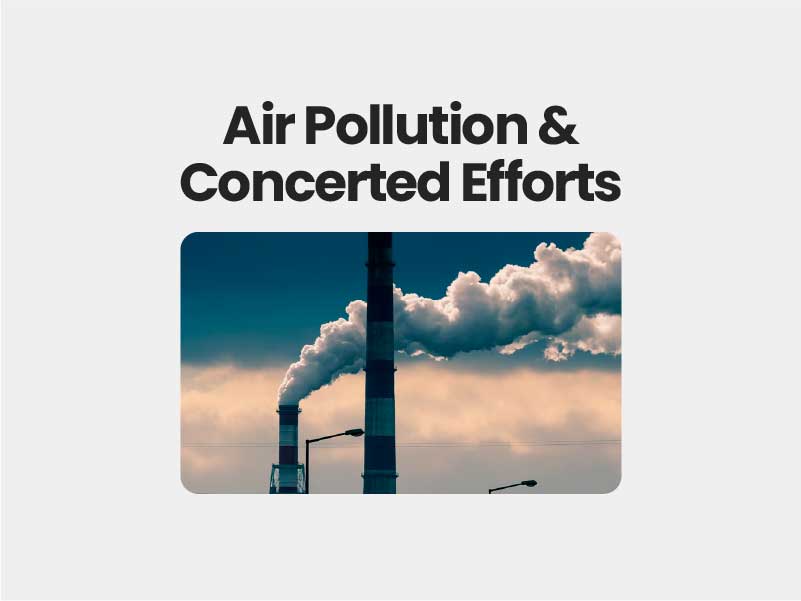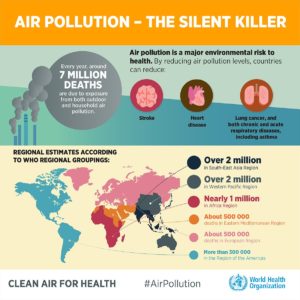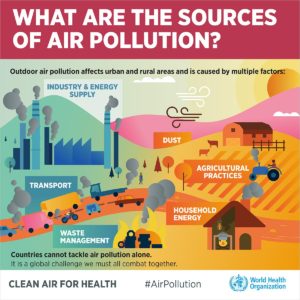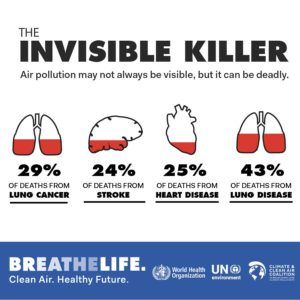Companion@360 → 7 Month programme to sharpen your writing skills → REGISTER NOW

Air Pollution & Concerted Efforts
- India’s air pollution problem needs to be tackled systematically, taking an all-of-government approach, to reduce the huge burden of associated ill-health.
- Deteriorating air quality due to the release of hazardous pollutants from multiple sources is a growing challenge.
- Most Indian cities report poor levels of air quality, threatening the health of its citizens and adversely impacting economic activity.
- If air pollution is not controlled, by 2030 the air will become so poisonous that it will be necessary to use an oxygen kit to breathe easily.
State of Global Air 2020 Report:
- State of Global Air 2020 (SoGA 2020) has been released by the Health Effects Institute (HEI)
- India, Bangladesh, Pakistan and Nepal are among the top ten countries with the highest PM2.5 (particulate matter) exposures in 2019 and all of these countries experienced increases in outdoor PM2.5 levels between 2010 and 2019.
- India is also among the top ten countries with highest ozone (O3) exposure in 2019. Also, among the 20 most populous countries, India recorded the highest increase (17%) in O3 concentrations in the past ten years.
- Long-term exposure to outdoor and household (indoor) air pollution contributed to over 1.67 million annual deaths from stroke, heart attack, diabetes, lung cancer, chronic lung diseases, and neonatal diseases, in India in 2019.
- High PM contributed to the deaths of more than 1,16,000 Indian infants who did not survive their first month.
WHO:
- WHO data shows that 9 out of 10 people breathe air that exceeds WHO guideline limits containing high levels of pollutants, with low- and middle-income countries suffering from the highest exposures.
- WHO is supporting countries to address air pollution.
AQI
- It helps the common man to judge the air quality within his vicinity.
- Index constituted as a part of the Government’s mission to improve the culture of cleanliness.
World Bank:
- According to a 2016 World Bank report, the lost lives and ill health caused are also a colossal economic burden.
- $225bn is lost labour income in 2013, or $5.11tn per year (about $1m a minute), if welfare losses are also added.
Source of Air Pollution
- Burning of Fossil Fuels
- Agriculture & Allied Sources(eg: Stubble burning)
- Natural Sources
Pollutants Causing Effect of Health:
- Mortality and burden of disease from unhealthy environments
- In children under five years, up to 26% of all deaths could be prevented, if environmental risks were removed.
- 12.6 million people died as a result of living or working in an unhealthy environment, representing 23% of all deaths.
- When accounting for both death and disability, the fraction of the global burden of disease due to the environment is 22%.
- particulate air pollution exposure during pregnancy is linked to low birth weight and preterm birth.
Air pollution is a major risk factor for heart disease, stroke, chronic obstructive pulmonary disease (umbrella term for several progressive lung diseases including emphysema) and lung cancer, and increases the risks for acute respiratory infections and exacerbates asthma.
Government Initiatives:
- Introduction of BS-VI emission standards
- Pradhan Mantri Ujjwala Yojana (Household LPG programme).
- National Clean Air Programme.
- Implementation of the Graded Response Action Plan (GRAP).
Way Forward:
- To address this multifaceted problem, solutions are needed to tackle existing challenges like knowledge gaps, institutional capacity, monitoring capabilities and data availability, policy enforcement and low levels of public awareness.
- Average pollution levels in India are declining over the past three years but these have been marginal, particularly in the Indo-Gangetic plains which see extremely high PM pollution especially during winter.
- After a decline in pollution due to the nationwide lockdowns after March, pollution levels are again rising and air quality is dipping to the ‘very poor’ category in several cities.
- WHO’s 4 Pillar Strategy: Expanding the knowledge base
- Monitoring and reporting
- Global leadership and coordination
- Institutional capacity strengthening
- Responsibility of Citizens
- Addressing Injustice




